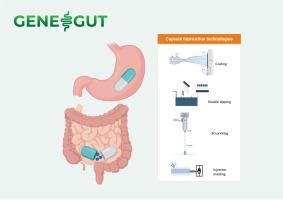新一代胶囊:胶囊制造和靶向口服给药的新兴技术。
IF 4.7
3区 医学
Q1 PHARMACOLOGY & PHARMACY
引用次数: 0
摘要
基于胶囊的药物递送已经取得了重大进展,为活性药物成分(api)提供了增强的保护,并实现了在胃肠道(GI)中精确、特定部位的释放。最近的创新,如肠溶包衣、双层包封(双浸)和先进的聚合物配方,扩大了胶囊的功能能力,为提高敏感分子(如肽、蛋白质和基于rna的疗法)的生物利用度和稳定性提供了机会。此外,尖端的制造技术——包括注射成型和3D打印——正在促进定制胶囊的生产,这些胶囊具有可控的释放曲线,从而最大限度地减少系统副作用并提高患者的依从性。本文综述了从单层到双层胶囊的技术进步,这是实现肠道特性和增强药物在胃液中降解的关键发展。我们探索了关键的胶囊制造技术,包括双浸、肠溶包衣,以及3D打印和注射成型等新兴方法,这些方法为精确给药和配方灵活性提供了新的可能性。通过整合这些进步,胶囊技术继续发展成为个性化和靶向口服药物给药的有前途的平台。未来的研究将集中在克服生产限制和进一步改进胶囊设计,以优化更广泛的胃肠道和全系统疾病的治疗效果。本文章由计算机程序翻译,如有差异,请以英文原文为准。

Next generation capsules: emerging technologies in capsule fabrication and targeted oral drug delivery
Capsule-based drug delivery has undergone significant advancements, offering enhanced protection for active pharmaceutical ingredients (APIs) and enabling precise, site-specific release in the gastrointestinal (GI) tract. Recent innovations such as enteric coatings, dual-layer encapsulation (double-dipping), and advanced polymer formulations have expanded the functional capabilities of capsules, offering opportunities to enhance bioavailability and stability of sensitive molecules like peptides, proteins, and RNA-based therapies. Additionally, cutting-edge manufacturing techniques—including injection molding and 3D printing—are facilitating the production of customized capsules with controlled release profiles, thereby minimizing systemic side effects and enhancing patient adherence.
This review examines the technological advancements from single-layer to double-layer capsules, a crucial development to achieve enteric properties and enhance drug protection against degradation in gastric fluids. We explore key capsule manufacturing technologies, including double-dipping, enteric coating, and emerging approaches such as 3D printing and injection molding, which offer new possibilities for precise drug delivery and formulation flexibility. By integrating these advancements, capsule technology continues to evolve as a promising platform for personalized and targeted oral drug delivery. Future research will focus on overcoming production constraints and further refining capsule design to optimize therapeutic efficacy across a broader range of gastrointestinal and systemic diseases.
求助全文
通过发布文献求助,成功后即可免费获取论文全文。
去求助
来源期刊
CiteScore
9.60
自引率
2.20%
发文量
248
审稿时长
50 days
期刊介绍:
The journal publishes research articles, review articles and scientific commentaries on all aspects of the pharmaceutical sciences with emphasis on conceptual novelty and scientific quality. The Editors welcome articles in this multidisciplinary field, with a focus on topics relevant for drug discovery and development.
More specifically, the Journal publishes reports on medicinal chemistry, pharmacology, drug absorption and metabolism, pharmacokinetics and pharmacodynamics, pharmaceutical and biomedical analysis, drug delivery (including gene delivery), drug targeting, pharmaceutical technology, pharmaceutical biotechnology and clinical drug evaluation. The journal will typically not give priority to manuscripts focusing primarily on organic synthesis, natural products, adaptation of analytical approaches, or discussions pertaining to drug policy making.
Scientific commentaries and review articles are generally by invitation only or by consent of the Editors. Proceedings of scientific meetings may be published as special issues or supplements to the Journal.

 求助内容:
求助内容: 应助结果提醒方式:
应助结果提醒方式:


